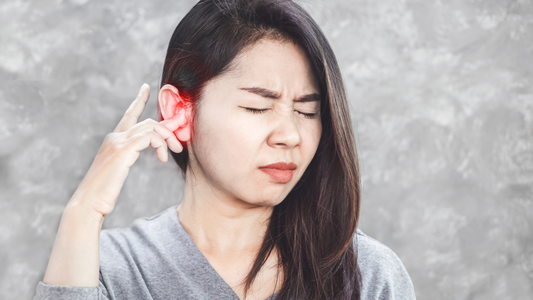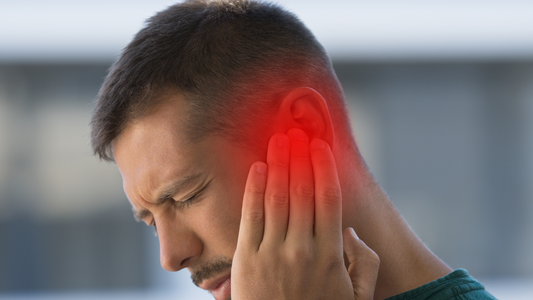Ever felt like your ears are ringing the alarm when everything's quiet? How about a buzz in your ear that's sticking around longer than the last guest at a party? We've all been there, that nagging sound that's not really there can drive you nuts. Well, it turns out, it could be more than just an annoyance, it might be a sign from your body – tinnitus.
If that word’s got you scratching your head, wondering what it’s got to do with that waxy stuff you clean out of your ears, grab a seat. We're about to chat about how too much earwax could be the unlikely conductor of your very own ear orchestra. And this isn't some snooze-worthy lecture. We’re talking good old-fashioned, clear-the-earwax, find-some-peace advice, sharing it as if we were swapping stories over a cup of joe.
What is Tinnitus?
Imagine sitting in a quiet room and suddenly there's a ringing in your ears that no one else can hear. That's a sneak peek into what tinnitus feels like. It isn't about actual bells or whistles around you; it's your ears signaling trouble. You might notice it as a buzz, hum, or even a relentless hiss that's always there, messing with your peace. For a good chunk of grown-ups, especially seniors, tinnitus is an unwelcome companion. And here's the kicker—it’s not even a condition on its own. Think of it as a red flag your body waves, hinting at something else going on in your hearing pathways. Could be a hint about the wax block party going on in your ear canal, or a nudge about a nerve-issue brewing in the background. Pulling the thread further, we'll explore just how that waxy buildup might just be throwing your ears off balance.
How We Hear

To get a handle on tinnitus, let's first break down how we pick up sounds. Our ears work like top-notch audio processors, seamlessly converting air vibrations into epic tales, groovy tunes, or our grandkids' laughter. When someone talks, their vocal cords send sound waves through the air, which then surf their way to our ears. Like catching a wave, our outer ear gathers these sound waves and funnels them down the ear canal to the eardrum, creating a little rumble as they strike.
The eardrum's vibrations are picked up by three small bones in the middle ear known as the ossicles. These bones are essentially the ear's version of a rock band, amplifying the sound and passing it on to the cochlea, the snail shell-shaped structure in the inner ear. Here, magic happens: vibrations are transformed into electrical signals that the auditory nerve shoots off to the brain. Voilà, the sounds of the world become the stories we hear.
But just like a static-filled phone call, tinnitus suggests there's a disruption in this seamless flow. The causes are myriad but knowing the hearing process helps pinpoint where the hiccup might be. It's like detective work where every clue brings us closer to solving the mystery and restoring silence.
How Does Impacted Ear Wax Cause Tinnitus?
Now, let's wade into how a bothersome wax blockage might lead your ears to that constant tinnitus tune. Earwax is typically the ear's housekeeper, trapping dust and safeguarding the ear canal. But sometimes, it throws a party and forgets to leave, piling up until it's a troublesome lump of blockage. If it clogs the canal, it’s like putting a cork in a bottle—the sound gets stuck and can't flow through.
The ear tries to adjust, and that’s when tinnitus can chime in. Think of your auditory system as a finely tuned orchestra; when the percussion section (in this case, sound waves hitting the eardrum) gets muted, other sections (like nerves in the ear) may start playing out of sync. This miscommunication with the brain creates that internal buzzing, hissing, or ringing, a phantom symphony no one wants a ticket to. The more impacted the wax, the louder the concert.
Moreover, if earwax presses against the eardrum, it can cause discomfort and further disrupt the ear's natural function. While it might feel like a small issue,impacted ear wax has the stage to set off quite the auditory disturbance.
How to Remove Impacted Ear Wax at Home
Wrestling with tinnitus when all you crave is silence can be frustrating. That wax buildup might be the culprit, and lucky for you, there's a way to tackle it without stepping outside your home. First, let's be clear: ear digging with cotton swabs is out. It can push wax deeper and might bring on more harm than good. Instead, let's talk about gentle, at-home methods to coax that stubborn wax out.
Oil it up – a few drops of baby or mineral oil, or even a simple olive oil from your kitchen can work wonders. Tilt your head and let the oil slide into the ear canal, giving it a good 5 to 10 minutes to soak in and soften the wax. Do this for a few days, and you'll set the stage for a smooth exit.
Warm Water Rinse
Once the wax is softened, it's time for a warm water rinse. This isn't high-pressure hosing; think more like a gentle, warm shower for your ear. A rubber-bulb syringe can be your tool here – just fill it with warm (not hot) water and squeeze it into the ear canal. Tip your head to let it drain out, taking the wax with it.
Patience and Safety
Remember, this isn't an overnight fix. It could take a few rounds before you notice an improvement. And if you're still faced with silence's elusive dance partner (tinnitus), it might be time to see a healthcare provider. They can ensure there's no other hidden cause for your concern, and they're well-equipped to safely bid farewell to that pesky wax.
The Final Note on Tinnitus and Ear Wax
Tinnitus, that uninvited ring or buzz in your ears, often has roots that are as mundane as a build-up of earwax. While we've explored how impacted earwax plays its vile tune, remember, this fixable issue doesn't deserve a front-row seat in your life.
By understanding the harmony of hearing and how a wax block can disrupt it, you give yourself the power to turn down the volume on tinnitus. So, give those at-home ear cleaning tips a shot. Should the issue persist or you suspect a deeper problem, that's when a professional could step in. And hey, if you're curious about the HearWell Group's hearing aid, it might just be the encore you need to enjoy the sound of silence once more. Stay tuned to your body's signals, and don't miss out on life's beautiful symphony.
Sources & References
- Schwartz, S. R., Magit, A. E., Rosenfeld, R. M., Ballachanda, B. B., Hackell, J. M., Krouse, H. J., Lawlor, C. M., Lin, K., Parham, K., Stutz, D. R., Walsh, S., Woodson, E. A., Yanagisawa, K., & Cunningham, E. R. (2017). Clinical Practice Guideline (Update): Earwax (Cerumen Impaction). Otolaryngology–Head and Neck Surgery, 156(1_suppl), S1-S29. https://doi.org/10.1177/0194599816671491
- Tunkel, D. E., Bauer, C. A., Sun, G. H., Rosenfeld, R. M., Chandrasekhar, S. S., Cunningham, E. R., Archer, S. M., Blakley, B. W., Carter, J. M., Granieri, E. C., Henry, J. A., Hollingsworth, D., Khan, F. A., Mitchell, S., Monfared, A., Newman, C. W., Omole, F. S., Phillips, C. D., Robinson, S. K., Taw, M. B., Tyler, R. S., Waguespack, R., & Whamond, E. J. (2014). Clinical Practice Guideline: Tinnitus. Otolaryngology–Head and Neck Surgery, 151(2_suppl), S1-S40. https://doi.org/10.1177/0194599814545325
- Guest, J. F., Greener, M. J., Robinson, A. C., & Smith, A. F. (2004). Impacted cerumen: composition, production, epidemiology and management. QJM: An International Journal of Medicine, 97(8), 477-488. https://doi.org/10.1093/qjmed/hch082
- Michaudet, C., Malaty, J. (2018). Cerumen Impaction: Diagnosis and Management. American Family Physician, 98(8), 525-529. https://www.aafp.org/pubs/afp/issues/2018/1015/p525.html
- Baguley, D., McFerran, D., & Hall, D. (2013). Tinnitus. The Lancet, 382(9904), 1600-1607. https://doi.org/10.1016/S0140-6736(13)60142-7

The Hear Well Group Research Team: Trusted Hearing Health Insights
Our experienced research team compiles hearing health data from credible, peer-reviewed sources and presents it in easy-to-understand terminology. We ensure accuracy and trustworthiness, providing up-to-date, evidence-based recommendations to enhance hearing care practices and inform our readers' hearing well-being decisions.


